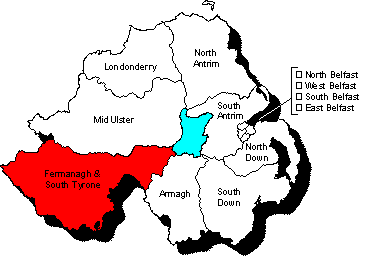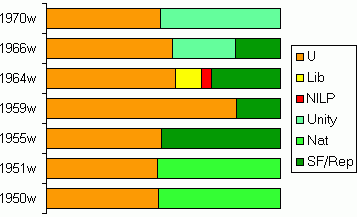

 |

|
|
|
|
|
Saturday March 29, 2025
|

|

|
| Map and diagram by Conal Kelly | |
This constituency takes in the largely rural south-western corner of Northern Ireland, including all of county Fermanagh and the southern portion of county Tyrone. Established in 1948, the constituency incorporated much of the old Fermanagh and Tyrone two-seat constituency. Between 1950 and 1970 the constituency was represented by five different MPs (2 Unionists, 1 Nationalist, 1 Sinn Fein, 1 Unity). All seven elections held during this period were contested. The constituency recorded the highest turnout in the UK in 1950, 1951, 1955, 1964 and 1966.
See also election results for Fermanagh & South Tyrone 1973-1982, 1983-1992 and 1993-2007.
| U | Lib | NILP | Nat | Unity | SF/Rep | |
| 1970w | 48.9% | 51.1% | ||||
| 1966w | 54.0% | 26.9% | 19.1% | |||
| 1964w | 55.1% | 11.0% | 4.3% | 29.6% | ||
| 1959w | 81.4% | 18.6% | ||||
| 1955w | 49.8% | 50.2% | ||||
| 1951w | 47.9% | 52.1% | ||||
| 1950w | 48.1% | 51.9% |
Unity majority: 1,423; electorate 70,381; votes cast: 91.2%
Despite increasing his vote over his 1966 tally, Hamilton was unable to defeat the sole nationalist candidate. At the time of the election McManus was chairman of the Fermanagh Civil Rights Association. In 1977 McManus was one of the founding members of the Irish Independence Party (IIP), becoming deputy leader in 1981. McManus was one of two successful Unity candidates in 1970, the other being Bernadette Devlin in the neighbouring Mid-Ulster constituency. Fermanagh & South Tyrone recorded the second highest turnout of the election in Northern Ireland.
In 1979, on his father's death, Hamilton became the fifth Duke of Abercorn, and sat in the House of Lords until the 1999 reforms.
Unionist majority: 14,707; electorate 63,188; votes cast: 86.0%
In the highest turnout of the election, the Unionists achieved a comfortable victory, with Hamilton improving on his 1964 majority. The nationalist vote was split by Unity candidate JJ Donnelly and Republican Rory Brady (aka Ruairí Ó Brádaigh). In 1957 Ó Brádaigh, a prisoner at the time, had been elected to the Dail on a Sinn Fein abstentionist ticket for the Longford-Westmeath constituency. In January 1970 Ó Brádaigh would play a lead role in the establishment of the Provisional movement, later becoming President of Provisional Sinn Fein. In 1986 he would lead another split over the policy of abstentionism, forming a new party called Republican Sinn Fein.
Unionist majority: 13,872; electorate 63,462; votes cast: 85.9%
Following
Grosvenor's retirement, the Unionists chose James (Marquess of)
Hamilton as their candidate (interestingly, Hamiton's wife and
Grosvenor's daughter-in-law, both now duchesses, are sisters, born
Natalia and Alexandra Philips). Sinn Fein was now a proscribed
organization so its supporters contested elections under the label
‘Republican’. The Liberals and the NILP also contested the
election in Mid-Ulster for the first and last time.
In the end Molloy was able to improve on Sinn Fein's 1959 tally but he
was still unable to attract sufficient numbers to outpoll Hamilton, who
won with a comfortable majority of almost 14,000. The constituency once
again recorded
the highest turnout across Northern Ireland.
The Liberals and the NILP respectively recorded their best and
worst results of the 1964 general election in Fermanagh and South Tyrone.
Unionist majority: 24,732; electorate 64,022; votes cast: 61.6%
Sinn Fein again contested the seat it had won in 1955. Despite being the sole nationalist candidate, Martin was roundly defeated by Grosvenor (later the 5th Duke of Westminster) who increased his majority to almost 25,000. Fermanagh & South Tyrone was a stark example of how the Sinn Fein vote collapsed right across Northern Ireland, as a result of the IRA's divisive Operation Harvest campaign.
Sinn Fein majority: 261; electorate 65,770; votes cast: 92.4%
This election
came at a time of increased militant republican activity. In October
1954 the IRA had attempted a raid on Omagh Barracks in order to capture
weapons for their planned Operation Harvest. The raid was a failure and
led to the capture of eight IRA members. One of those captured and
imprisoned for his part in the raid was Philip Clarke. Clarke was
subsequently selected to represent Sinn Fein in Fermangh & South Tyrone.
Unopposed on the nationalist side, Clarke topped the poll in one of the
closest races of the election. Only 261 votes separated Clarke from his
Unionist rival, a fact that when compared with previous elections
indicate a possible level of discomfort on the part of some nationalist voters in
electing a convicted IRA member. Clarke was subsequently declared ineligible
due to his imprisonment and on the October 25, the Unionist runner-up Col.
Robert Grosvenor was declared elected without a by-election.
Clarke was one of two Sinn Fein candidates elected in 1951, the other being
Thomas Mitchell in Mid-Ulster. This was the first time since 1918 that any
Sinn Féin candidate had been elected to Westminster.
Nationalist majority: 2,635 electorate 67,219; votes cast: 93.4%
In the highest
turn-out of the election, Healy managed to slightly increase his
majority over his Unionist rival. Healy, who had previously been
elected on an abstentionist ticket, would ultimately take up his seat
at Westminster in 1952.
Patterson would later stand unsuccessfully as an Independent Unionist
for the Northern Ireland House of Commons in the 1968 Lisnaskea
by-election.
Nationalist majority: 2,311 electorate 67,424; votes cast: 92.1%
This was the
first election fought in the new Fermanagh & South Tyrone constituency
and was the closest results of the 1950 general election in Northern
Ireland. Recording the highest turnout of the election, the result was a
narrow win for the veteran Nationalist Cahir Healy. This election saw the
elimination of the two-seat constituency which was replaced by Fermanagh &
South Tyrone and Mid-Ulster. This was one of two seats won by the
Nationalists in 1950; the other being the neighbouring Mid-Ulster.
Healy had an interesting electoral history previously representing the
two-seat Fermanagh and Tyrone constituency between 1922-1924 and then
again between 1931-1935. At the time of the election Healy was also a
member of the Northern Ireland
House of Commons representing Fermanagh South, and continued to serve
in that capacity until 1968, by which time he had become the Father of
the House.
See also:
Results from 1950 to 1970 for each seat: East Belfast | North Belfast | South Belfast | West Belfast | North Antrim | South Antrim | Armagh | North Down | South Down | Fermanagh and South Tyrone | Londonderry | Mid Ulster
Other sites based at ARK: ORB (Online Research Bank) | CAIN (Conflict Archive on the INternet) | Northern Ireland Life and Times Survey
Your comments, please! Send an email to me at nicholas.whyte@gmail.com.
Conal Kelly, 1 June 2007.
|
|
Disclaimer:©
Nicholas Whyte 1998-2004 Last Updated on Wednesday, 12-Jan-2005 12:12
|